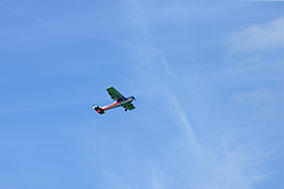 |
Why Learn to Fly? |
The debate over quite when a human being first took to the air using a man-made apparatus is unlikely ever to be resolved, but our yearning to infiltrate the dominion of the birds must be as old as the first sparks of self awareness in our ancestors. The worship of bird gods, wish-fulfilling fantasies of sky-dwelling mythological heroes and the spirit-flights of shamans were common themes in cultures across the globe many millennia before early Chinese aviators left the ground strapped onto oversized kites. In Greek legend, Daedalus' son Icarus paid the ultimate price for flying too high on makeshift wings, losing his life when he fell to earth - an unambiguous warning against daring to reach for the sky. Yet the dream of flight itself refused to die.
Returning to reality; Michelangelo's audacious concepts for rotary-wing aircraft were flawed but still five centuries ahead of their time and the idea of heavier-than-air flying machines patiently gestated as humankind's engineering expertise caught up with its imagination. The Montgolfier brothers' pioneering flight of 1783 triggered a craze for hot air ballooning that undoubtedly reinvigorated the struggle to develop truly pilotable aircraft. By the middle of the nineteenth century the brilliant engineer Baronet George Cayley of Brompton had unlocked the secrets of the cambered wing and indentified the quartet of forces - weight, lift drag and thrust - that govern mechanical flight. Thanks to the trailblazing Yorkshireman's groundwork in aerodynamics and aeronautical engineering only one obstacle to powered aircraft remained: without an effective lightweight motor the problem of weight versus thrust was insurmountable. Fortunately a number of inventors were already working on the principles of what was to become the internal combustion engine. Finally, in December 1903, mid-western bicycle repairmen Orville and Wilbur Wright's first powered fixed-wing flight ignited a conflagration of technological creativity that saw the aeroplane progress from the homemade contraption that spluttered above the sand flats of Kitty Hawk for just 120 feet to machines capable of high altitude supersonic flight in a little under 44 years.
Today, General Aviation is a pastime that unifies people from all walks of life in a shared passion and genuine feeling of community. Notwithstanding the bland ubiquity of cheap airline travel, learning to fly a light aircraft remains one of the greatest adventures and is a wonderfully rewarding pursuit. Many people are drawn to gaining a private pilot's licence in order to enjoy the unmatched sense of freedom (even in the crowded UK airspace of the 21st Century), the intimate connection with the currents of the atmosphere that only piloting a small aircraft can provide, and the sheer beauty of viewing our world from aloft.
Some are understandably daunted by what can seem a bewilderingly complex universe of jargon and unfamiliar terminology, but a private pilot's licence is well within the reach of almost anyone who enjoys the challenges of lifelong learning. Nor is it prohibitively expensive. Modern GA continues to keep pace with technology: viable eco-friendly electric engines are just around the corner, whilst such advances as 'glass cockpit' avionics and the adoption of GPS and mobile devices for flight planning and navigation continue to make inroads to the world of General Aviation. And so the adventure of flight continues.
Why fly? Because you can!
MAK AVIATION FLIGHT SCHOOL
London Elstree Aerodrome | Borehamwood | Herts WD6 3AW | tel: 020 8236 9308
© MAK Aviation 2019
